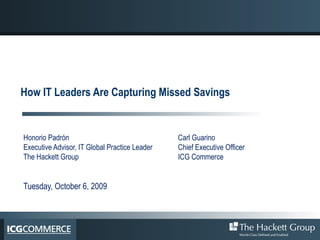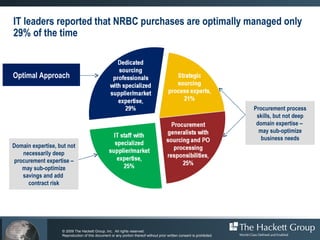IT Leaders: A Guide to Doing More with Less
- 1. How IT Leaders Are Capturing Missed Savings Honorio Padr├│n Executive Advisor, IT Global Practice Leader The Hackett Group Tuesday, October 6, 2009 Carl Guarino Chief Executive Officer ICG Commerce
- 2. About Our Speakers Carl Guarino Chief Executive Officer ICG Commerce CEO since 2006 Extensive experience guiding the strategic development and growth of companies into global enterprises Prior experience includes 18 years at SEI Investments, a leading global provider of outsourced asset management Honorio Padr├│n Executive Advisor, IT Global Practice Leader The Hackett Group 30 years in business technology, enterprise business transformation and customer experience engineering Prior experience includes CIO of Exelon Corporation, CompUSA and PepsiCo Restaurant Group and Head of Global Reengineering for Burger King Corporation
- 3. Executive Summary The current business environment has created significant challenges for IT leaders Declining revenues are driving greater focus on SG&A spending and accountability IT organizations are under pressure to deliver more innovation with fewer resources and budget dollars Despite cost pressures, most IT organizations are leaving significant cost savings on the table by under-managing up to 1/3 rd of outside purchases IT executives from leading companies are stretching or reducing budgets by millions of dollars per year, without sacrificing critical resources or activities, by gaining greater visibility and control over these purchases
- 4. IT leaders are being challenged to do more with less in todayŌĆÖs environment Heightened demand for more IT support : Drive more innovation for the business and for customers Increase agility and scalability Improve the customer experience Deliver business intelligence more rapidly Manage ever-increasing security risk Yet increased pressure on costs : Reduce spending without compromising service and quality to help offset declines in revenue
- 5. Recent Performance Study: Approximately 1/3 of indirect spend is under-managed Spend Demographics ŌĆō Spend by ŌĆ£TypeŌĆØŌĆ” Study Focus
- 6. IT leaders reported that NRBC purchases are optimally managed only 29% of the time Procurement process skills, but not deep domain expertise ŌĆō may sub-optimize business needs Domain expertise, but not necessarily deep procurement expertise ŌĆō may sub-optimize savings and add contract risk Optimal Approach
- 7. IT leaders report lukewarm satisfaction with chosen suppliers, turnaround time, pricing and contract flexibility Avg.= 3.42 Strongly Disagree Neutral Strongly Agree Study respondent: ŌĆ£ Purchase Bureaucracy implies too many levels of approval, which slows down the process and depletes confidence from buyers in a fast purchase.ŌĆØ
- 8. Why is this spend problematic and difficult to address? Requires deep IT expertise Supply market dynamics are rapidly changing Wide range of projects call for knowledge of broad spectrum of complex goods/services Tight timeframes require rapid supplier identification, evaluation and selection Conflicting priorities or limited capacity can result in a sub-optimal process Project demand is highly variable Unexpected projects can arise based on changing business strategy Planned projects may be postponed or accelerated Difficult to predict far enough in advance to staff appropriately
- 9. Closing the spend influence gap and improving sourcing effectiveness can have a big impactŌĆ” * Moving from 62% of spend competitively bid to World-Class performance levels of 91.13% ** 3.53% is the difference between World-Class Procurement savings level sand non-World-Class (for indirect spend) Illustrative example: $10B CPG Co. 5-Year Program Savings: $12.5 ŌĆō $22.5MM $22.5 $4.5 $4.5 $4.5 $4.5 $4.5 Savings reported by those who manage/track project spend Incremental savings opportunity if optimally managed Per year NRBC IT/Telecom Spend $30MM Savings currently reported $2.0MM Additional savings created by managing more spend* $0.9MM Additional savings by adopting sourcing best practices** $1.6MM Total additional savings opportunity $2.5MM Total annual savings on project spend $4.5MM
- 10. Critical elements to closing the gap... Scalable ŌĆśCenter of ExcellenceŌĆÖ dedicated to sourcing NRBC spend Sourcing experts with specific IT domain expertise Modified process that balances rigor with business unit timeframes. Not a choice between 100-step full sourcing process or 2-step tactical sourcing process. Tools and technology that support tracking and prioritization of projects Savings calculation methodology unique to NRBC spend This gap can be closed internally if the company is prepared to bear the cost and time to build an internal infrastructure; Alternatively, companies can leverage scalable, third-party solutions.
- 11. Case Study: Global Manufacturer Significant portion of IT spending going to one-time purchases (e.g., SaaS providers, website design, migration services, printer managed services) 70+ projects per year across globe, ranging from $75K to $1.4MM per project No standard process to address Procurement organization does not have bandwidth to support Primarily managed directly by IT; Procurement manages some spend on ad hoc basis Significant challenges in staffing internally: Demand is highly variable Regional complexities require specific knowledge of local supply markets Desire to focus internal resources on core business activities Situation :
- 12. Response : To address these challenges, company tapped scalable, third party expertise Dedicated global teams of sourcing professionals with deep IT expertise (from specialized software to consulting projects to major hardware purchases) Modified process balances speed and sourcing rigor (4 weeks vs. 4 months) Contract experts readily available to review / facilitate agreements Scalable activity based on client demand Capital and Project Sourcing Desk (ŌĆ£CAPS DeskŌĆØ): Variable pricing and delivery model Software Hardware Telco Marketing Software Hardware Telco Capital Equip Services Marketing Dedicated Category Sourcing Experts Software Hardware Telco Capital Equip Services Marketing Software Hardware Telco Capital Equip Services Marketing APJ North America Europe Tools and Market Intelligence Accelerated Sourcing Process Specific Savings Calculation Methodology
- 13. 1 ┬Į years into program, average of 21% savings Added structure and diligence without slowing down process Freed business resources from sourcing activities IT organization reports gaining access to more purchasing options, the best possible life-cycle value for their budget dollars, and significant time savings Contracting expertise leveraged to mitigate company liability and risk Results : Program highlights
- 14. Sample IT sourcing projects Project Purchase Timing Spend Savings % Purchase code maintenance appliance to improve development time Code Maintenance Appliance 2 weeks $100K 65% Develop custom software (content delivery platform) for Marketing organization Content Delivery Software 4 weeks $400K 17% Enterprise Data Management (EDM) roadmap development by 3 rd party consultants EDM Roadmap 8 weeks $320K 20% Global implementation of EIPP project in conjunction with Accounts Payable Electronic Invoicing 12 weeks $540K 24%
- 15. Benefits of leveraging CAPS Desk Average 3-4X ROI Tap into deep IT sourcing expertise and information when and as needed to meet changing demand No implementation or infrastructure investments Pay for what you use with a variable pricing model Contract specialists readily available to ensure risk is mitigated and vendors are held accountable to agreed upon terms Focus IT talent on core business activities
- 16. How to get started Review a copy of the Hackett study on project sourcing spend Contact ICG Commerce for a project spend diagnostic and savings opportunity analysis Test drive the CAPS Desk for 2-3 upcoming projects Contact Chris Todd ICG Commerce [email_address] 484-690-5136
Editor's Notes
- #13: 12 ║▌║▌▀Ż Objective: Create a common understanding of the definition of Commercial Print Key Points: Before I begin, letŌĆÖs make sure we all understand the acronym Commercial Print. In some cases itŌĆÖs almost easier to describe what Commercial Print is not. Commercial Print is not Direct Material, Capital Equipment or Contract Services. It is products that are used to operate and maintain facilities. Within Commercial Print, there are typically two kinds of ŌĆ£buys.ŌĆØ One is stockroom replenishment. The second is non-stock, or ŌĆ£spot buyŌĆØ purchases for material that is used as soon as it is received.















![How to get started Review a copy of the Hackett study on project sourcing spend Contact ICG Commerce for a project spend diagnostic and savings opportunity analysis Test drive the CAPS Desk for 2-3 upcoming projects Contact Chris Todd ICG Commerce [email_address] 484-690-5136](https://image.slidesharecdn.com/it-leaders-a-guide-to-doing-more-with-less3131/85/IT-Leaders-A-Guide-to-Doing-More-with-Less-16-320.jpg)